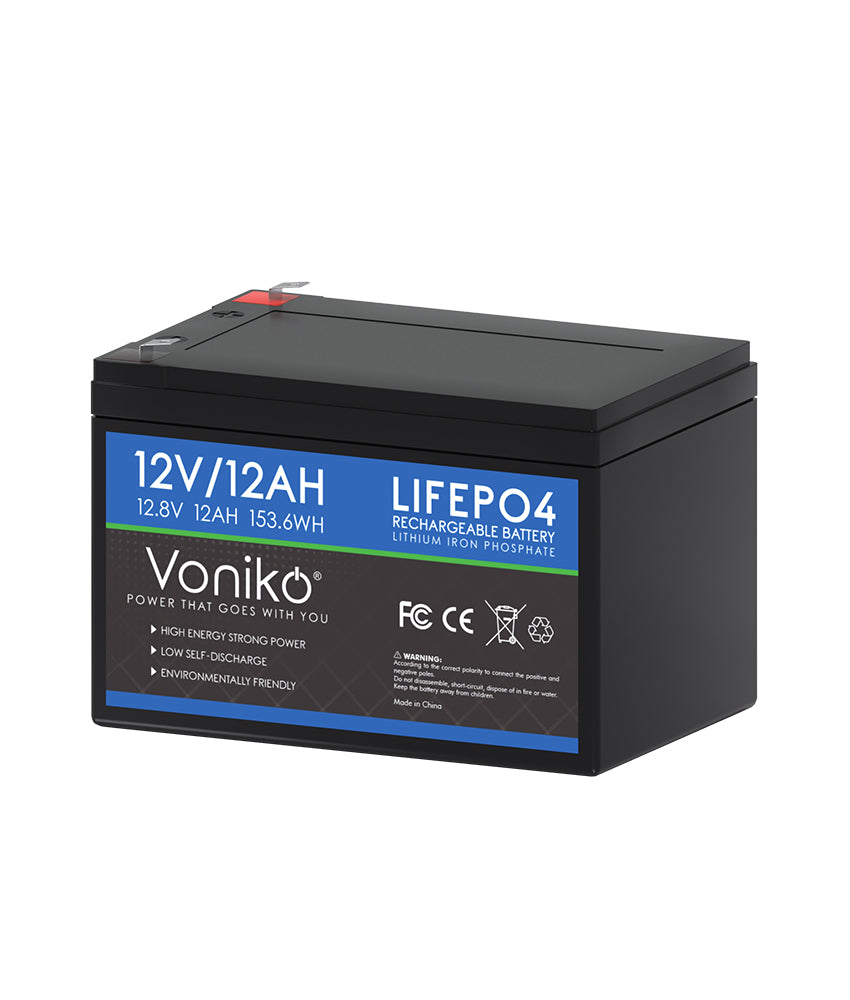When your Blink camera stops working right when you need it most, there's usually one culprit – dead batteries. We've all been there, checking our security footage only to find our camera went dark hours ago. Don't worry though, we're here to help you keep those cameras powered up and protecting your home 24/7.
At Voniko, we understand how frustrating battery failures can be, especially when it comes to your home security. That's why we've put together this complete guide to help you choose the right batteries for your Blink cameras and make them last as long as possible. Whether you're using AA batteries or looking into lithium options, we've got you covered with everything you need to know.
What Type of Batteries Do Blink Cameras Use?
Most Blink camera models run on two AA batteries, though this can vary depending on which model you have. The Blink Indoor, Outdoor, and Mini cameras typically use standard AA batteries, while some newer models might have different requirements. Before you rush to the store, check your camera's battery compartment or user manual to be absolutely sure.
Here's what you need to know about Blink camera battery compatibility. These cameras are designed to work with both alkaline and lithium AA batteries, but the performance difference between these two types is huge. While alkaline batteries might seem like the budget-friendly choice, they often fall short when it comes to outdoor cameras that face temperature extremes and high power demands.
Pro tip: Always use the same brand and type of batteries in both slots. Mixing different battery types or brands can cause uneven discharge, which might damage your camera or give you unreliable performance.
Why Lithium Batteries Are Your Best Choice for Blink Cameras
When it comes to powering your Blink cameras, lithium batteries are hands down the best option. They last significantly longer than alkaline batteries – we're talking about 2-3 times longer in most cases. This means fewer battery changes, less hassle, and better security coverage for your home.
Lithium batteries perform much better in extreme temperatures, which is crucial if you have outdoor Blink cameras. While alkaline batteries can lose up to 50% of their capacity when temperatures drop below freezing, lithium batteries keep delivering consistent power even in harsh winter conditions. This reliability is especially important for security cameras that need to work year-round.
The upfront cost of lithium batteries might be higher, but they're actually more cost-effective in the long run. When you factor in their longer lifespan and better performance, you'll save money and reduce the frequency of battery replacements. Plus, you'll have peace of mind knowing your cameras won't suddenly die during a cold snap or heat wave.
How Long Do Batteries Last in Blink Cameras?
Battery life in Blink cameras depends on several factors, but most users can expect anywhere from 1-2 years with lithium batteries under normal usage. This estimate assumes you're recording about 40,000 seconds of video per month, which covers typical home security needs.
However, real-world battery life varies based on how you use your cameras. If you have high-traffic areas that trigger frequent recordings, or if you use live view often, your batteries will drain faster. Cold weather, poor Wi-Fi signal strength, and frequent motion alerts can also reduce battery life significantly.
Here are some typical battery life expectations:
- Light usage (fewer motion triggers): 2+ years with lithium batteries
- Normal usage (moderate motion detection): 1-2 years with lithium batteries
- Heavy usage (frequent triggers, live viewing): 6-12 months with lithium batteries
- Alkaline batteries: Generally 30-50% shorter than lithium in all scenarios
Keep in mind that Blink cameras are designed to be energy efficient, using advanced power management to extend battery life. They only wake up when motion is detected or when you access them remotely, which helps conserve power between uses.
Signs Your Blink Camera Batteries Need Replacement
Don't wait for your Blink camera to completely die before replacing the batteries. There are several warning signs that indicate it's time for fresh batteries, and catching these early can prevent security gaps in your home monitoring.
The most obvious sign is the low battery notification in your Blink app. When your batteries drop to about 20%, you'll get an alert on your phone. Don't ignore this warning – batteries can die quickly once they hit this threshold, especially in cold weather or with heavy usage.
You might also notice performance issues before getting a low battery alert. These include delayed motion detection, shorter recording times, poor video quality, or connection problems. If your camera seems sluggish or unreliable, weak batteries could be the problem.
Watch for these warning signs:
- Low battery notifications in the Blink app
- Reduced motion detection sensitivity
- Shorter video clips than your settings specify
- Frequent disconnections from Wi-Fi
- Delayed notifications when motion is detected
- Grainy or poor-quality video footage
Tips to Maximize Your Blink Camera Battery Life
Getting the most out of your Blink camera batteries doesn't require any special tech skills – just some smart settings adjustments and good habits. These simple changes can significantly extend your battery life and reduce replacement frequency.
Start by optimizing your motion detection settings. The default sensitivity might be too high for your specific location, causing unnecessary recordings that drain your batteries. Adjust the sensitivity and motion zones to focus only on areas where you actually want alerts. This reduces false triggers from things like moving shadows, pets, or passing cars.
Temperature plays a huge role in battery performance, so consider your camera placement carefully. If possible, install outdoor cameras in shaded areas or use protective housings to shield them from extreme temperatures. Even a few degrees can make a noticeable difference in battery longevity.
Here are more battery-saving tips that actually work:
- Reduce video length: Shorter clips use less power
- Limit live view usage: Only check live feeds when necessary
- Optimize Wi-Fi signal: Weak signals force cameras to work harder
- Use activity zones: Focus detection on specific areas only
- Regular maintenance: Keep camera lenses clean for efficient operation
Choosing the Right Battery Brand for Your Blink Camera
Not all batteries are created equal, and this is especially true for high-drain devices like security cameras. While your local store might have dozens of battery options, choosing the right brand can make a huge difference in performance and reliability.
At Voniko, our lithium batteries are specifically designed for high-performance devices like security cameras. Our SCM (Super Conducting Material) Technology ensures consistent power delivery throughout the battery's entire lifespan, which is crucial for devices that need reliable performance.
When shopping for Blink camera batteries, look for these important features:
- Long shelf life: Quality batteries maintain their charge for years
- Temperature resistance: Essential for outdoor cameras
- Consistent voltage: Prevents performance drops as batteries age
- Leak protection: Protects your expensive camera equipment
- High capacity: More power means longer runtime between changes
Avoid bargain-brand batteries or "heavy duty" alkaline options for your security cameras. These might work fine for TV remotes or wall clocks, but they're not designed for the demanding power requirements of modern security devices.
Troubleshooting Common Blink Camera Battery Issues
Sometimes Blink camera battery problems aren't actually about the batteries themselves. Before you blame dead batteries for camera issues, it's worth checking a few other common culprits that can mimic battery problems.
Poor Wi-Fi signal is one of the biggest battery drains that most people don't consider. When your camera struggles to maintain a connection, it works overtime trying to reconnect, which rapidly depletes battery power. Check your signal strength in the Blink app and consider adding a Wi-Fi extender if the signal is weak.
Firmware issues can also cause unusual battery drain. Make sure your Blink cameras and app are updated to the latest versions. Sometimes a simple restart (removing and reinserting batteries) can resolve software glitches that cause excessive power consumption.
Common issues and quick fixes:
- Camera won't turn on: Try different batteries or check battery orientation
- Rapid battery drain: Check Wi-Fi signal and motion sensitivity settings
- Inconsistent performance: Ensure you're using the same battery type in both slots
- Low battery alerts with new batteries: Clean battery contacts and restart camera
- Camera randomly disconnecting: May indicate weak batteries even if not showing low
When to Replace vs. Upgrade Your Blink Camera Batteries
Knowing when to simply replace batteries versus when to upgrade to better ones can save you money and frustration in the long run. If you're constantly dealing with dead batteries or poor camera performance, it might be time to upgrade your battery choice rather than just replacing with the same type.
If you're currently using alkaline batteries and experiencing frequent replacements or cold weather failures, switching to lithium batteries is a no-brainer upgrade. The initial cost difference pays for itself quickly through longer life and better reliability.
For cameras in extreme environments or high-usage areas, consider investing in premium lithium batteries with advanced features like our POWER LOCK technology, which prevents self-discharge and ensures your batteries maintain full power even after months of storage.
Consider upgrading when:
- Replacing batteries more than twice per year
- Dealing with cold weather performance issues
- Experiencing frequent low battery alerts
- Camera performance seems inconsistent
- You want better long-term reliability
Remember, your home security is only as reliable as the power source behind it. Investing in quality batteries isn't just about convenience – it's about ensuring your family's safety and protection are never compromised by preventable power failures.
With the right batteries and proper maintenance, your Blink cameras can provide years of reliable security monitoring. Whether you choose our premium lithium options or stick with high-quality alkaline batteries, the key is consistency and quality. Don't let dead batteries leave your home unprotected when a simple upgrade can give you peace of mind and reliable performance year-round.




















